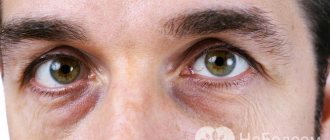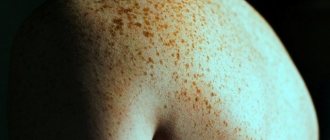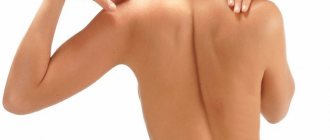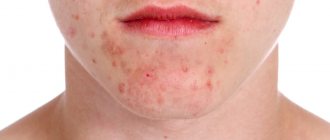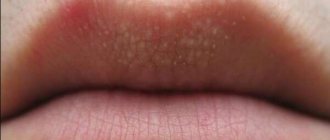White spots: what are they and what are their features
The appearance of a white or light spot is evidence of a lack of melanin production. This problem can be caused by both skin diseases and malfunctions of the whole body.
Some white dots may appear due to stress or metabolic characteristics, changes in hormonal levels. Pregnant and lactating women often suffer from this problem.
Usually, over time, the tone of their face evens out. Sometimes cosmetic and medical procedures .
It is better to immediately talk to your doctor about any skin spot that appears.
Nevus
The disease is considered a benign formation. It can be congenital or appear on the skin at any age. Such tumors are called moles. Nevi do not require special treatment. They do not have a negative impact on human life.
The appearance of moles is influenced by several factors:
- Local developmental defects.
- Heredity.
- Direct sunlight.
- Injuries;
- Hormonal background.
- Viruses.
- Infection.
Nevi are divided into several groups:
- Congenital.
- Purchased.
The main task of diagnosing a nevus is to determine whether the formation is benign or malignant. If melanoma is detected, urgent therapy is required, since it concerns a person’s life.
The patient is assigned a special examination consisting of several steps:
- Survey.
- Visual inspection.
- Dermatoscopy;
- Indication using phosphorus isotopes.
- Echography;
- X-ray.
- Thermometry.
- Biopsy.
After the biopsy, treatment of nevi begins. Doctors usually do not use drug treatment because it does not have much effect. The drugs are used only if the occurrence of moles is associated with another pathology. Usually the mole is removed surgically.
To avoid the appearance of malignant moles, it is necessary to follow a number of preventive measures:
- Avoid direct exposure to sunlight.
- Avoid dry skin.
- Treat skin diseases.
- Do not injure the skin.
- Avoid interaction with aggressive substances.
- Get examined by a dermatologist.
Causes
Light areas on the skin of the face are formed due to different production of melanin pigment. Some diseases and other problems in the body can provoke this situation, for example:
- pityriasis rosea;
- stress;
- pregnancy and lactation;
- Tan;
- metabolic disorders;
- weak immunity;
- diseases of the liver, thyroid gland, gastrointestinal tract;
- avitaminosis;
- fungal infections;
- allergic reactions;
- taking certain medications;
- hormonal imbalances;
- vitiligo;
- leucoderma.
The most dangerous diseases are those that cause discoloration of the skin of the face.
Pityriasis rosea occurs as a result of a viral disease. The spread of the disease occurs from one point. Subsequently, the entire body is covered with light white spots. In this case, a person does not experience any particular discomfort, since the spots do not itch and can go away on their own over time.
If they cause aesthetic and psychological discomfort , then it is worth visiting a doctor to prescribe procedures to speed up the healing process.
Tanning can also cause white spots. The reason for this phenomenon is partial convergence of the skin. The epidermis appears under the sunburned areas. To make such spots disappear, you need to apply burn cream and wait for them to heal.
Fungus is another cause of skin discoloration. Such spots tend to cause inflammation, severe itching and redness. The disease itself can be chronic and should be treated comprehensively and under the strict supervision of a doctor, following all his recommendations, otherwise even greater inflammation will appear on the skin.
Vitiligo is one of the most serious causes of depigmentation of the upper layer of the epidermis. The spots caused by this disease are brighter. They are located on the face, hands and inner surface of the arms.
At first, the spot that appears may be more convex, but over time it acquires a uniform structure. The reason for their appearance is the destruction of melanocytes due to immune disorders or viral diseases. Vitiligo can be caused by:
- hereditary causes;
- work in some types of production;
- stress;
- nervous breakdowns;
- hormonal imbalance.
Vitiligo may be preceded by Setton's nevus. This disease is characterized by the appearance of white spots around moles after heavy tanning. They become spots, which subsequently grow and occupy a large surface of the skin.
Leucoderma is not the name of a disease, but a process of skin discoloration. It is caused both by certain diseases and by poisoning with chemicals or medications.
These are not all diseases that can cause skin discoloration. Only a doctor can identify the cause of the problem in detail and accurately .
If a pimple or rash appears on the skin, then, regardless of color, you need to monitor its dynamics and immediately consult a doctor for an accurate diagnosis.
Fungal infections
Typically, fungal diseases form pronounced pigmented zones on the skin that have a precise geometric shape. Moreover, the affected areas slightly rise above the surface of the skin. Sometimes the skin begins to peel off and bumps appear. From a minor injury, areas of the skin affected by the fungus may begin to enlarge, and oozing ulcers appear.
If the fungus affects the feet, the skin becomes thinner, erosion and severe peeling occur. This disease is very difficult to cure.
If the fungus has affected the scalp, the hair becomes dull and looks unhealthy. Gray bumps appear on the skin. This indicates the occurrence of local alopecia. There are a lot of fungal diseases, it all depends on the pathogen that provoked the disease.
The most common are:
- Rubromycosis. The disease can have several forms. Large, reddish, very scaly spots appear on the skin. Vesicles and papulas are visible on the surface. These manifestations can cause the appearance of follicles and numerous nodules.
- Microsporia. It is expressed as a focal lesion and looks like a small circle. The inflamed area is located in the very center. It is dotted with scales and also small blisters. The affected areas are severely peeling. There are practically no many foci; if they arise, their rapid merging is observed.
- Trichophytosis. Usually exposed areas of the body are affected. The disease is highly contagious and can be transmitted through clothing. The infection is characterized by a large scarlet circle. Upon visual examination, small nodules are clearly visible. Severe peeling is visible on most areas of the skin. Severe inflammation is observed along the edges of the formation.
- Pityriasis versicolor. Mostly young people get sick. The fungus affects:
This type of lichen is distinguished by pink spots that are covered with slight peeling. These spots may enlarge and become brighter in color.
5. Seborrheic dermatitis. Can only be transmitted by humans. The source of the disease is a lipophilic fungus. The hairline is mainly infected.
Flaky inflammation appears on the scalp. Sometimes you can see hemorrhagic crusts. The disease causes severe itching. Scratching causes abscesses.
6. Candidiasis. It is characterized by a red tint to the skin with a large number of small blisters. As the disease progresses, the formations look more saturated and erosion appears. The body folds are mainly affected. Very rarely the soles of the feet and palms of the hands are affected.
Depending on the type of mycotic pathogens, other manifestations of the fungus are known:
- The appearance of flaky blisters.
- Soaking wounds, severe pain.
- Rejection of the epidermis.
- Formation of white spots.
- Unpleasant smell.
- Fever.
- Deterioration of the immune system.
- Runny nose.
- Weakness.
The nail plates become covered with a yellow coating, begin to crumble, and become loose.
White spots on the skin are a symptom of a fungal disease. To completely get rid of the disease, you can use folk remedies, as well as medications. Treatment by a dermatologist is carried out using therapeutic measures, as well as special treatment of hygiene items to prevent secondary infection.
| Cause | Drugs |
| Swelling, weeping manifestations, secondary infection. | Triderm, Mikozolon, Lotriderm, Lamisil. |
| Attenuation of the inflammatory process | Fluconazole, Ketoconazole, Miconazole, Econazole, Bifonazole, Isoconazole, Clotrimazole, Metronidazole, Naftifine, Terbinafine, Undecine, Zincundan, Octicyl, Decamine. |
| Systemic treatment | Intraconazole, Fluconazole, Ketocornazole, Terbinafine, Naftifine. |
| To enhance the antiallergic response | Sulfur, vitamin A. |
The appearance of white spots in children
The appearance of light or white spots in children can be caused by the same reasons as in adults. However, there are a number of others:
- manifestations of albinism;
- consequences of an infectious disease.
In the latter case, the child may also experience some disturbances in the functioning of the central nervous system and a delay in mental development.
The most common cause of white spots in children is tanning. The top layer of skin partially comes off and areas of the epidermis become visible underneath. Treatment is carried out only after consultation with a doctor and identification of the exact cause of the pathology.
Hypomelanosis
The disease is considered a type of leukoderma when melanin formation slows down. This condition is very diverse. The main role in the development of the disease is played by the characteristics of the organism at the genetic level.
Scientists have proven that hypomelanosis mainly occurs due to strong ultraviolet radiation. Sometimes this may be due to the use of medications.
In rare cases, signs of disease may include dysembryogenesis:
- Malformation of the bone apparatus.
- Heart diseases.
- Diseases of the genital organs.
- Nervous system disorders.
Hypomelanosis has several varieties, differing in clinical manifestations. Moreover, the classification takes into account various pathological conditions, as well as hereditary predisposition.
The main forms of the disease are:
- Guttate hypomelanosis.
- Ito.
- Idiopathic hypomelanosis.
There is no definitive treatment for hypomelanosis. Therapeutic actions are aimed at removing age spots using local drugs. The dermatologist prescribes injections of corticosteroids that enhance the activity of melanogenesis.
Retinoids, special preparations based on placenta extract, are also used. It contains a large number of biogenic stimulants, thanks to which the process of the appearance of melanocytes is accelerated.
How to get rid of stains
You can remove light spots on your face. To do this, it is best to consult a dermatologist. He will conduct a thorough examination and tests. Based on the results obtained, treatment will be selected. It can be:
- salon beauty treatments;
- medical preparations.
If you don’t trust doctors and cosmetologists, you can use traditional recipes, but their effectiveness has not been proven and there is a high risk of harming your health.
If a white spot appears on the face, first of all it is necessary to eliminate the cause of its appearance and concomitant diseases.
Melagenin Plus
This drug is used to treat Vitiligo. With its help, melanin production is restored.
The main function of melagenin is considered to be:
- Improved blood circulation.
- Anti-inflammatory effect.
- Saturation of skin cells with moisture.
The medicine is rubbed into the skin, directly onto the spots. If the affected areas are exposed to ultraviolet radiation, a positive effect will occur within 2 to 3 months.
Home methods
Home treatment methods involve the use of traditional medicine. It can be:
- decoctions and herbal teas;
- masks;
- compresses;
- lapping.
Their effectiveness has not been medically proven, but some products successfully help fight skin pigmentation and even out complexion.
Traditional medicine can be used after consultation with a doctor and only after preliminary testing on the skin to identify a possible allergy to the components.
Herb tea
Herbal tea is taken orally. To make it you will need:
- sage;
- series;
- St. John's wort;
- calendula;
- nettle;
- oregano
You will need 4 tablespoons of sage, nettle and St. John's wort, 3 tablespoons of calendula and string and 2 tablespoons of oregano. The resulting mixture can be stored for a long time in a dry, ventilated place.
To prepare one serving of tea, you need to brew 2 teaspoons of the mixture in half a liter of water. The tea is infused in a thermos for at least two hours. You need to drink it three times a day before meals. The course of treatment is two months, after which a break is needed for at least the same period.
What microelements should be present in food?
A light spot may also appear due to a lack of useful elements in the body. For prevention, you need to pay attention to your diet. It is necessary to enrich it with products with:
- copper;
- zinc;
- iron;
- vitamins A, E, B.
As often as possible, eat fresh fruits and vegetables, some berries rich in vitamins, seafood, buckwheat, some legumes, dairy products (with normal lactose tolerance), seeds, nuts, beef or chicken liver.





